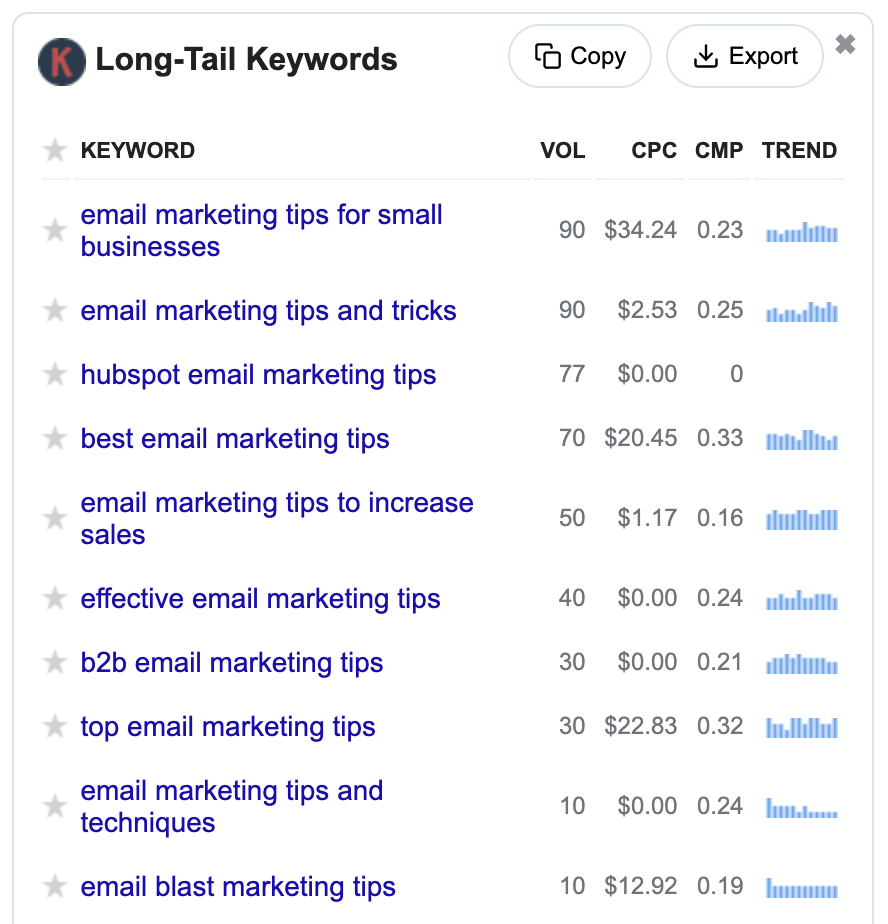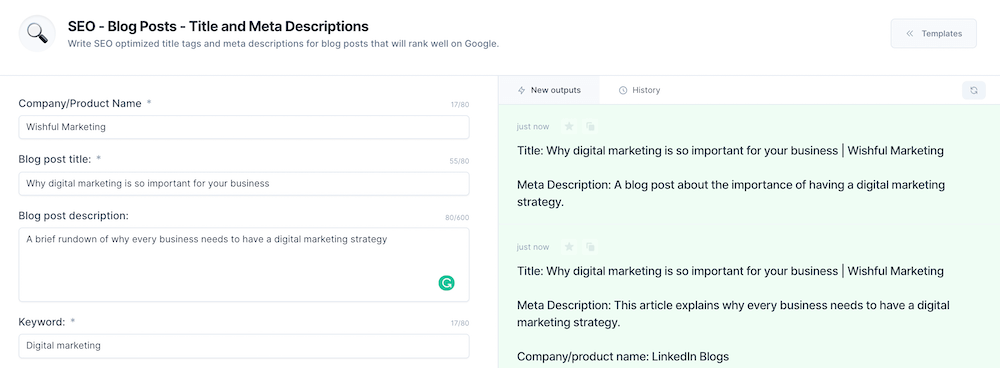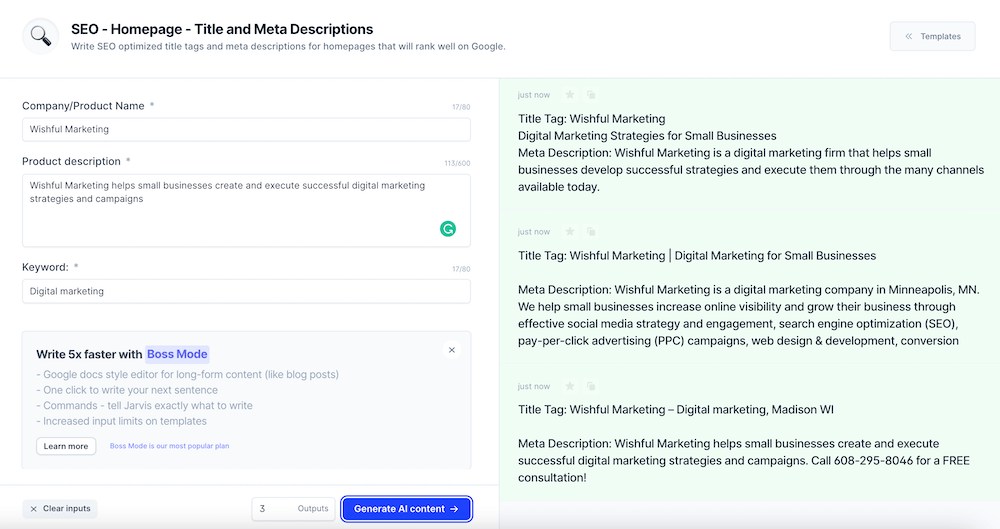Free
How to Write SEO Title Tags That Will Make Your Website Stand Out
Make your SEO title tags shine with our top tips and tricks for getting noticed in search results.
When you search on Google, you’re faced with countless options. But how do you decide which one to click? Well, most of the time it’s the result with the most captivating title tag – the title of the search result.
Sample SEO title tags for email marketing tips
All of these results promise to provide email marketing tips, but they present them in different ways. Sounds simple, right? Well, it actually has a big impact on getting people to click on your page and how your website ranks overall.
Here’s everything you need to know about creating engaging page title tags.
What is an SEO title?
An SEO title is a tag that’s applied to the HTML code of a webpage to specify what the page is called. When you see a search result, it’s usually the title you see first. It’s also displayed on web browser tabs and on social media when someone shares the page. Its purpose is to let searchers and social media users know what they can expect from a webpage. It also helps search engines rank pages based on relevant keywords.
There are two goals you want to achieve with your SEO title tags:
1. Let searchers know what your page is about.
2. Entice searchers to click through to your page.
Why are SEO title tags important?
In addition to providing clarity about your page’s content and avoiding disappointment for searchers, SEO title tags have several other important roles.
SEO: We’ll delve into this more later, but the more focused and descriptive your tags are, the more likely they are to rank for your primary keyword.
Stand out: The more clickable and engaging your title tag is, the more likely a searcher is to choose your page over a competitor.
Showcase your brand: Using consistent formatting that includes your brand name in title tags can increase brand awareness.
By the way, in August 2021, Google made a change to how SEO title tags are generated and displayed. If Google thinks your title tag isn’t relevant or descriptive enough, it may generate its own version for you. But most of the time, Google will stick with your original tag, so it’s important to have a high-quality SEO title.
6 tips for writing optimized SEO title tags
You’re probably eager to learn how your title tags can boost your search rankings. After all, they’re a crucial part of your optimization efforts since they’re often the first thing people see before visiting your webpage.
So, how can you make the most of your title tags?
1. One keyword to rule them all
While it may be tempting to stuff your title tag with multiple keywords, it can actually harm your rankings. Instead of a scattergun approach, focus on one main keyword and build your SEO title around that. For example, if your main keyword is “email marketing tips,” don’t overdo it by including multiple mentions of “email marketing.”
Bad: 13 Email Marketing Tips to Make Your Email Marketing Better
Good: 13 Email Marketing Tips that Will Dramatically Increase Engagement
Using just one keyword is enough for search engines to understand your page’s content. Adding more can make your titles sound forced and robotic instead of compelling.
2. Feel free to use long-tail keyword variations

While we advised focusing on one keyword, it doesn’t mean you can’t use long-tail variations of it. Including more context helps both search engines and searchers understand what makes your page different from others in the search results.
Don’t go overboard – choose just one or two long-tail keywords. For example, continuing with the email marketing example, you might select “email marketing tips for small businesses” as your long-tail keyword to create a title tag like:
13 Powerful Email Marketing Tips for Small Businesses
This title tag incorporates both the focus keyword and a long-tail keyword for an added impact. Using long-tail keywords provides more context to your title and can help you rank faster.
3. Be descriptive
Google’s main aim is to deliver the most relevant results to searchers. The more descriptive you can be about your page, the better Google can understand it and show it to the right people.
Use your title tag to dive deep into what your webpage is about and set clear expectations for readers from the start.
4. A Quick Guide to SEO Titles: How to Keep Them Short and Sweet
When it comes to SEO titles, you want to make sure they don’t get cut off by Google. A truncated title could mean missing out on important information and losing potential visitors. To avoid this, aim for a title length of around 50 to 60 characters (keep in mind that Google measures in pixels!).
5. Put Your Keyword Front and Center for Maximum Impact
While it’s hard to say if keyword placement directly affects rankings, having it at the beginning of your title tag can instantly convey what your page is about to searchers. Make it clear from the get-go what they can expect from clicking on your page.
6. Why Every Page Needs Its Own Unique Title
It might be tempting to use the same title for all your pages, especially if you have a lot of them. But doing so confuses search engines and doesn’t provide much information about each individual page. This, in turn, can lower your click-through rate. Make it a point to give each page its own unique title tag, clearly indicating what it’s about and what visitors can expect.
Get Ready to Stand Out in Searches with SEO Title Tag Best Practices!
Now that you’re ready to optimize your SEO titles for search engines, it’s time to start writing them with confidence. Follow these best practices to make sure you’re putting your best foot forward:
1. Say goodbye to capitals
Avoid writing your SEO meta title in all caps. While it might catch attention, it’s not for the right reasons. Instead, use sentence case or title case for a more professional look.
For example:
– Capitals (not recommended): 13 EMAIL MARKETING TIPS TO IMPROVE OPEN RATES
– Sentence case (recommended): 13 email marketing tips to improve open rates
– Title case (recommended): 13 Email Marketing Tips to Improve Open Rates
2. Be human and relatable
Remember, your goal is to impress Google, but don’t forget that Google wants to impress its human users. Don’t cram your titles with keywords just for ranking purposes. Write as if you’re speaking directly to your audience and address what they would want to know about your page.
3. Highlight quick wins
When people search, they often want quick solutions or immediate answers. If your title tag promises a speedy solution or a quick win, it’s more likely to attract clicks. You can use words like “quick” or “simple,” but go a step further and emphasize how quickly a reader can solve their problem. Choose phrases like “in X minutes,” “in one day,” “today,” or “now.”
4. Showcase your well-known brand
If your brand is recognized in your industry, don’t shy away from including it in your SEO title tag. This adds credibility, increases brand awareness, and positions you as a trusted resource.
5. Numbers make a difference
List posts are popular because they provide easily scannable information. If your page includes a list in any form, always include a number in your title tag to catch attention.
6. Use powerful words
Remember that searchers are humans with emotions. Incorporating power words in your SEO title tags can give them the push they need to click through to your webpage. Some impactful words to consider are “amazing,” “sensational,” “remarkable,” “revolutionary,” “magic,” “miracle,” and “startling.”
For example:
– 13 Revolutionary Email Marketing Tips to Use Right Now
– 13 Email Marketing Tips You Can Use Right Now
7. Add punctuation for added appeal
While you have limited space for your SEO title tags, you can use punctuation to break them up and make them more visually appealing. Try incorporating parentheses or brackets to provide extra information and context about your page.
Here are some examples:
– 13 Revolutionary Email Marketing Tips (That Actually Work)
– How to Set Up Shoppable Campaigns (And Drive More Sales)
– What is a CRM (and Why It’s So Important)
Follow these practices to make your SEO titles shine and attract attention in search results!
How to Create SEO Titles with Jasper
Boost your SEO with the power of AI! If you’re unsure where to begin, Jasper has a variety of SEO title tag templates designed for different types of pages. This is especially useful when you need to generate multiple SEO title tags at once, which can be a huge headache during an SEO audit.
Creating SEO Titles for Blog Posts

With Jasper’s SEO title generator, it’s as simple as entering your company name, blog post title, and topic. Jasper will then generate a selection of title tags and meta descriptions for you.
Creating SEO Titles for Your Homepage

Let Jasper take care of the hard work for you! Just provide a little information about your company and target keyword, and Jasper will generate the perfect SEO title for your homepage.
Creating SEO Titles for Product Pages

Describe your product and Jasper will create a selection of title tags that incorporate that information. It couldn’t be easier!
Creating SEO Titles for Services
Tell Jasper about the service you’re promoting, and let its powerful AI content generator come up with multiple potential tags for you.
Find inspiration with these incredible title tag examples:
1. CoSchedule – Best practices covered: list format with a high number, focus keyword, power word, added context.
2. WordStream – Best practices covered: list format, focus keyword, an added sense of curiosity.
4. Practically Functional – Best practices covered: brand name, human wording, highlights a quick win.
5. Make Web Better – Best practices covered: focus keyword, punctuation.
6. Innity – Best practices covered: focus keyword, brand name, added context for curiosity.
7. Adam Enfroy – Best practices covered: focus keyword, punctuation, list format, added context.
Make your SEO title tags shine in Google search results.
Now that you know what it takes to create an effective SEO title tag, it’s time to work on your own. Remember to focus on one main keyword, write for humans (not just Google), and watch your rankings soar while giving searchers a clear idea of what to expect from your web pages.






























